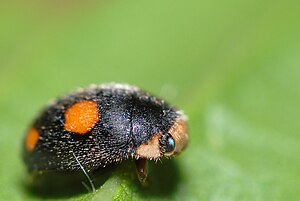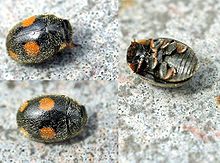Tansy ladybug
| Tansy ladybug | ||||||||||||
|---|---|---|---|---|---|---|---|---|---|---|---|---|

Tansy ladybug ( Platynaspis luteorubra ) |
||||||||||||
| Systematics | ||||||||||||
|
||||||||||||
| Scientific name | ||||||||||||
| Platynaspis luteorubra | ||||||||||||
| ( Goeze , 1777) |

The tansy ladybug ( Platynaspis luteorubra ) is a ladybug from the Chilocorini tribe.
features
The beetles are 2.5 to 4.8 millimeters long and have a very hairy body. Your two wings are black and each have two large orange-red dots. The two points in front are larger than the two at the ends of the wings. On the sides of the downwardly curved neck shield is also depending on a small red spot. The frontal plate ( clypeus ), the front part of the pronotum, completely encloses the compound eyes. This is a differentiator from other small species of ladybirds. The clypeus is yellowish white in the males and black in the females. The compound eyes, like the rest of the body, are black.
The rails ( tibia ) of the legs of the tansy ladybird are clearly widened in an arc shape on the inner and outer edge.
Occurrence
The animals are widespread in Europe , where they are often found on the plants of large sandy areas, but also on loamy soil. They prefer biotopes in which the vegetation is kept short, for example on roadsides or mown areas along the highways. This is probably related to the ecological demands of the ant species with which this myrmecophilic ladybird species occurs. These include the black garden ant ( Lasius niger ) and, to a lesser extent, the wrinkled knot ant ( Myrmica rugulosa ). The habitat of the ant species Myrmica scabrinosus and Myrmica sabuleti , however, is avoided.
Way of life
Similar to many other species of ladybirds, the larvae and adults of the tansy ladybird feed on aphids of the Aphididae family . The beetles are in competition with the ants that feed on the honeydew of these aphids. The larvae of the tansy ladybirds are more common in the aphid colonies grazed by ants than in those without ants. This could be due to the fact that the larvae have an unusual shape and inconspicuous locomotion for ladybugs and possibly a chemical camouflage , which makes it difficult for the ants to recognize. This gives them an advantage in the aphid colonies that are cared for and protected by ants over other aphid predators, which are often attacked by the ants.
Pupae and adult tansy ladybirds are more likely to be attacked by the ants than the larvae. However, the pupae protect themselves with a thick coat of hair, the adult beetles press themselves tightly against the leaf or the plant surface and, thanks to their hemispherical shell, offer little surface to attack.
Ladybirds are often found on grass roots, in dead hedges and in the flowers of hawthorns. The adults hibernate under the bark of various trees, especially firs and willows, but also plane trees.
supporting documents
Individual evidence
- ↑ Wolfgang Völkl: Behavioral and morphological adaptations of the coccinellid, Platynaspis luteorubra for exploiting ant-attended resources (Coleoptera: Coccinellidae). Journal of Insect Behavior, 8, 5, pp. 653-670, 1995
- ↑ a b Species Account for Platynaspis luteorubra . www.essexfieldclub.org.uk. Retrieved December 12, 2019.
literature
- W. Dekoninck, K. Desender, P. Grootaert, J.-P. Maelfait, L. Baert, D. De Bakker and T. Adriaens: Observations of the ladybird Platynapsis luteorubra (Goeze) on motorway verges along the ring-road of Brussels, with comments on its habitat and host preference (Coleoptera Coccinellidae Chilocorinae). Bulletin SRBE / KBVE, 140, pp. 123–125, 2004 full text (PDF, English; 1.8 MB)
Web links
- Platynaspis luteorubra at Fauna Europaea
- Tansy ladybird description and Dutch distribution map (nl.)
- www.kerbtier.de

